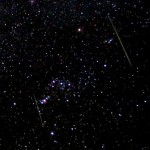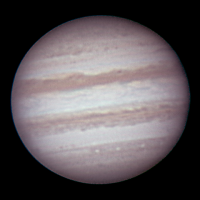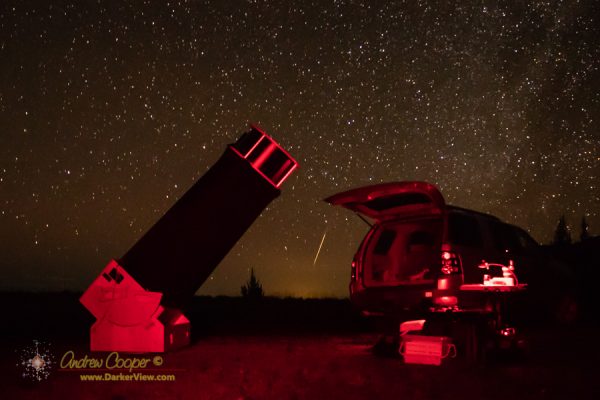
Tag: meteor
Orion and Meteor
Violet and a Meteor
Leonid Meteor Shower
The Leonids are one of the better known annual meteor showers. Some years see high Leonid activity, with amazing numbers of meteors. This shower has occasionally created true meteor storms. Unfortunately 2019 is not predicted to be one of those years, with very modest numbers expected.

Due to the gravitational influence of Jupiter, the Leonids are not expected to produce any exceptional showers for some decades. We are unlikely to see any repeats of the early 21st century storms anytime soon.
The shower will peak on November 17, with an expected ZHR of around 15 meteors per hour. The Leonids exhibit a broad peak allowing viewing for days before and after maximum. Moonlight is a bit of an issue with a waning gibbous Moon 5 days after full on the 17th.
Perseid Meteor Shower
Over the next week the Perseid meteor shower will peak. As the most reliable shower each year this is also the most viewed meteor shower. Plentiful shooting stars combined with warm summer evenings makes this shower the easiest and most comfortable to view across much of the northern hemisphere. Quite a difference from the other reliable showers such as the Leonids and Quadrantids, that occur in November and January. Consider a warm summer night under a dark sky full of stars, a picnic blanket, relaxing while shooting stars streak across the sky. What could be better?

The Perseid meteor shower occurs when the Earth passes through a stream of debris along the orbit of Comet Swift-Tuttle. This shower has been consistent throughout recorded history, mentioned in Chinese, Japanese and Korean records as early as the 1st century. Active from July 17th to August 24th, the shower will build slowly for weeks before the peak. A week before or after peak the shower can still be seen with around 20 meteors each hour. The shower is a northern hemisphere event, for southern observers the radiant never rises above the horizon.
Continue reading “Perseid Meteor Shower”Eta-Aquariid Meteor Shower
The early hours of dawn on May 6th will see the peak of the η-Aquariid meteor shower. This is a reliable shower that produces anywhere from 30-80 meteors each hour near peak. Known for fast moving meteors that have a tendency to leave glowing, persistent trains, the η-Aquariid meteors may be one of the best bets for island observers in 2019.

Resulting from debris left behind by Comet 1P/Halley this shower approaches the Earth from the direction of the constellation Aquarius. As this constellation is quite low in the sky during the shower the meteors are entering the atmosphere at a low angle, this often results in meteors with long trains crossing much of the sky. A good shower that produces great fireballs.
Continue reading “Eta-Aquariid Meteor Shower”Quadrantid Meteor Shower
The first meteor shower of 2019 is the annual Quadrantid meteor shower. The Quadrantids are a reliable shower, producing 60-120 ZHR, one to two meteors per minute. The Quadrantids are named for the obsolete constellation Quadrans Muralis, now part of the constellation Boötes.
Unlike other showers where activity can occur for days or even weeks, the Quadrantids have a sharp peak, activity falls off rapidly on the preceding and following nights, or even a few hours away from the peak. Thus it is important to observe the Quadrantids quite near the peak prediction.
This year’s peak is calculated for January 4th at 02:20UT, this would be January 3rd at 16:20HST, well timed for observers in Europe, not favorable for observers in these islands. For northern observers the radiant is circumpolar, thus the shower is observable all night long. Given our 20° latitude here in Hawaii the radiant does not rise until 01:30HST, thus observations must wait until well into the morning hours.
New Moon on January 6 creates optimum viewing conditions for the expected Quadrantid maximum on January 4. For many northern hemisphere sites, the shower’s radiant is circumpolar, in northern Boötes, from where it first attains a useful elevation after local midnight, steadily improving through till dawn. The 02h UT timing for the peak will be favourable for European longitudes. The λ⊙ = 283 . ◦16 maximum timing is based on the best-observed return of the shower ever analysed, from IMO data collected in 1992, as confirmed by radio results in most years since 1996. It also coincides with the closest approach to the stream calculated by Jérémie Vaubaillon (λ⊙ = 283 . ◦17). The peak is short-lived with an average duration (full width at half maximum) of about four hours. Hence it can be easily missed if the observer is located outside the “main observing window” – IMO 2019 Meteor Shower Calendar
Watching meteors requires no more equipment than your eyes and a dark sky, and can be enjoyable for just about anyone. While most observers in the northern hemisphere must endure winter conditions to observe this shower, in the islands we have the option of observing from somewhat warmer locations. I think this year’s Quadrantids deserve an early wake-up and a trip into the dark!
Geminids
The annual Geminid meteor shower has become one of the most reliable annual meteor showers. Known for bright and slow moving fireballs the Geminids can provide a good reason to spend a few hours outside on a December night. This shower has routinely provided rates above 100 meteors per hours in past years, this year should be no exception.

The peak is expected to occur around December 14, 06:30UT. For viewers here in Hawaiʻi this occurs on the evening of December 13th. The Geminids feature a broad peak, with high rates for nearly 24 hours, thus allowing the all time zones a decent chance to enjoy the show.
There should be no substantial moonlight to drown out this years showing, dark skies to allow even the faintest meteors to be seen. The Moon is a thin waxing crescent, 1% illuminated on the morning of the 13th, essentially new.
The Geminid radiant rises round 8pm, thus meteors should be visible all night long. You can stay up late or set the alarm early, your preference. Southern viewers will have to wait until around midnight for the constellation Gemini to rise, making this a morning shower.
Watching meteors requires no more equipment than your eyes and a dark sky, and can be enjoyable for just about anyone. Well? It is December, you should probably add a warm coat to the equipment list.
Quadrantid Meteor Shower Reminder
A reminder that tonight is the peak of the annual Quadrantid meteor shower. Peak will occur around 04:00HST tomorrow morning, January 3rd. Given our 20° latitude here in Hawaii the radiant does not rise until 01:30HST, thus observations must wait until well into the morning hours. A first quarter moon will set early leaving a perfectly dark morning sky for meteor observing.
Watching meteors requires no more equipment than your eyes and a dark sky, and can be enjoyable for just about anyone.
The Sky for 2017
Looking ahead to 2017 it appears that the skies will be kind to us this coming year. We have good meteor showers, a total eclipse of the Sun, a bright comet or two, and the usual planetary conjunctions to look forward to. Below you will find some on my notes to what we can look forward to during the coming year.

Covered are elongations for Mercury and Venus, interesting conjunctions, oppositions, eclipses and meteor showers. Posts include notes for visibility in the Hawaiian islands for those events that are location dependent.


